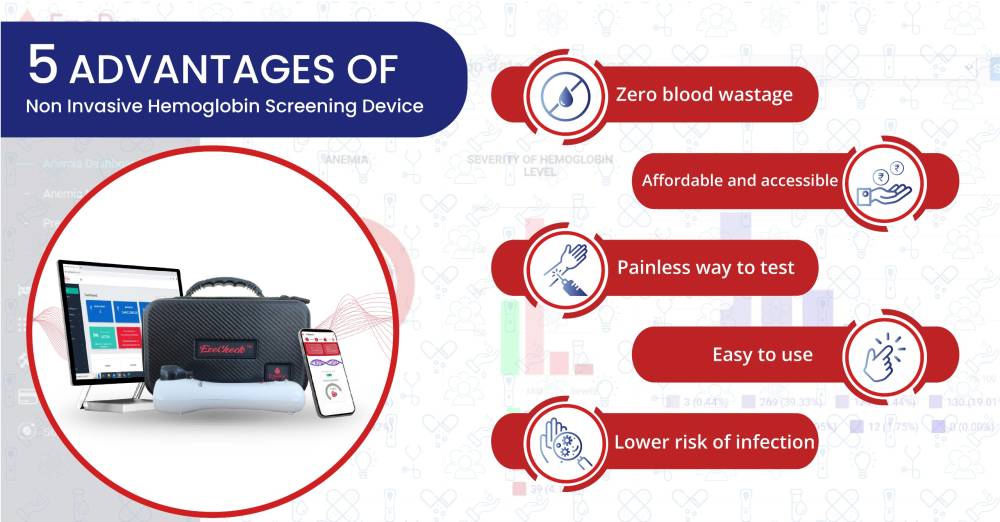
Technological advances have changed the world. With the rise of AI, many new possibilities have opened up. This next-generation technology has also improved the healthcare sector. With the help of non-invasive technology, the definition of patient care has been changed. Doctors can now reduce patients' pain during treatment, especially in surgical care, trauma surgery, and critical care. Now, the question arises:
It is a non-surgical procedure, which means it is conservative, does not remove tissue, and doesn't require incisions. Individuals with blood diseases like anemia can check their hemoglobin levels easily and regularly in a non-invasive way. How? Today, several non-invasive hemoglobinometers are available, such as EzeRx's EzeCheck Non-invasive Hemoglobin Meter. These devices are particularly helpful for patients with severe injuries or those who have undergone surgery. Non-invasive hemoglobinometers are revolutionizing the traditional way of diagnosing and treating illnesses. These devices are hassle-free, blood-free, easy to use, and AI-enabled. At this moment, two basic forms of non-invasive devices exist in the market: continuous hemoglobin monitors and spot-check hemoglobin monitors. The former one can constantly check hemoglobin, while the latter can give real-time results.
Hemoglobin tests can be categorized as either invasive or non-invasive. The former way of testing involves the use of needles for pricking, whereas non-invasive testing methods eliminate the need for needles, ensuring a painless experience when assessing hemoglobin levels. Non-invasive techniques leverage technologies such as light-based measurements or sensors capable of detecting and analyzing hemoglobin levels. One example involves absorbance spectroscopy, which assesses hemoglobin by measuring its interaction with tissues or blood vessels. This approach ensures accurate hemoglobin level measurements without causing discomfort or pain to the individual, offering a pain-free testing experience for patients.
The traditional method of hemoglobin testing typically requires a minimum of 1.5ml to 4ml of blood. However, the introduction of a prickless blood monitor eliminates the need for blood extraction. This non-invasive approach involves placing a finger in a specialized device or scanning the retina, enabling individuals to check their hemoglobin levels within a minute, without the discomfort of pricking. Opting for a non-invasive hemoglobin device not only offers a convenient and quick testing method but also ensures zero blood wastage.
This becomes particularly crucial for patients who have undergone surgery or experienced blood loss due to an accident. In such cases, where additional blood loss poses risks, using a non-invasive hemoglobin meter allows doctors to easily track the patient's blood levels without any potential threats. This advancement in testing technology not only enhances patient comfort but also contributes to the overall safety and well-being of individuals undergoing medical procedures or recovering from traumatic events.
In the case of traditional blood tests, multiple processes are involved. Initially, individuals requiring the blood test must visit a healthcare professional for the procedure, which includes pricking. Subsequently, patients endure a waiting period of at least 3-4 hours before receiving the test results. This process can be cumbersome and inconvenient. In contrast, non-invasive devices offer a more straightforward approach. By simply placing a finger in the device, doctors can quickly assess the patient's hemoglobin levels and identify potential blood diseases.
Additionally, non-invasive devices are portable, making them easy to carry. This portability is particularly advantageous in scenarios such as government-organized health awareness camps in rural areas, where these devices serve as invaluable tools. The efficiency and accessibility of non-invasive devices contribute to more streamlined and convenient health monitoring, especially in outreach initiatives targeting underserved populations.
A blood test conventionally involves the use of needles, which introduces the potential risk of infection. However, with the adoption of a non-invasive hemoglobin device, the necessity for needles is eliminated, as it requires no blood sampling. This not only ensures a comfortable experience for the patient but also simplifies and reduces the risks associated with the testing process.
Performing a non-invasive hemoglobin screening is safe and does not mandate the involvement of a healthcare professional. Untrained staff or even the patients themselves can conduct this type of test, enhancing accessibility and convenience. The avoidance of pricking in the non-invasive hemoglobin meter significantly minimizes the risk of infections, streamlining the overall testing procedure and simplifying waste disposal protocols. This advancement in testing methodology not only prioritizes patient comfort but also contributes to the safety and efficiency of the healthcare process.
In India, traditional hemoglobin testing methods can cost between 100 to 500 INR. However, non-invasive monitoring presents a more affordable alternative, exemplified by EzeRx's EzeCheck: the world’s first non-invasive hemoglobin screening device. Using EzeCheck requires only 14 rupees from the patient, making it a cost-effective option.
Furthermore, rural areas of India often face challenges with limited healthcare infrastructure and a scarcity of healthcare professionals. In such instances, a non-invasive device with offline capabilities, like EzeCheck, proves to be a valuable solution. This feature allows the device to function even without an internet connection, ensuring accessibility and usability in areas with limited connectivity. The affordability and offline functionality of non-invasive devices contribute to overcoming barriers to healthcare access, especially in rural settings where resources may be scarce.
A significant portion of the population doesn't regularly monitor their hemoglobin levels. However, tracking hemoglobin levels is crucial for various reasons, as it allows for the early detection of conditions such as anemia and other chronic diseases. This proactive approach enables individuals to gain a better understanding of their health and monitor potential issues. In this regard, EzeCheck by EzeRx offers a solution.
EzeCheck, recognized as the world's first non-invasive hemoglobin screening device, stands out for its affordability, accessibility to healthcare, and ability to provide instant results. This IoT-enabled hemoglobin screening device is user-friendly, requiring no professional expertise for operation. Its non-invasive nature eliminates the need for blood sampling, ensuring no wastage and reducing the risk of infection. Additionally, the portability of the device adds to its convenience. By incorporating EzeCheck into routine health monitoring, individuals can proactively manage their well-being, benefiting from a hassle-free and efficient testing experience.